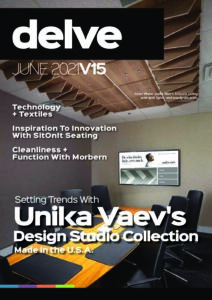Thinking back to January 2020, who could have predicted that hand sanitizer would be one of the hottest selling products of the year, or that extreme cleanliness would become a critical determinant in the operability of restaurants, hotels, schools and offices? The impact of COVID-19 on these businesses is certainly painful to measure. But what did it teach us about our work going forward? Is there a new preference for design and materials? At least two elements stand out: the need for spacing and the importance of cleanable materials. Let’s take a look at cleanable materials.
One year ago, the COVID-ravaged world needed something that could ensure a clean and safe environment. Not just standard cleanliness, but clinical cleanliness. The best surfaces, both soft (think upholstery) and hard (think countertops), for impeccable hygiene are solid, unbroken, and impermeable. They serve as both a barrier between the product and user, and a flat surface that can’t hide dirt and germs.
Coated fabrics like PVC (vinyl) and PU meet those needs. They serve as an excellent barrier that’s cost effective, safe, cleanable and impermeable. Although the ability to withstand cleaners depends on the fabric’s coating, many vinyls and some PUs are bleach-cleanable.
This used to be an asset only desired by the healthcare market, but with the onset of COVID-19, many commercial interiors markets found themselves in need of highly cleanable surfaces that would withstand daily disinfection routines.
With solid surfaces like vinyl, the buck stops here. Or at least the germs do. A solid surface will always outperform a woven textile when it comes to cleanliness and durability. And there is no better upholstery choice when it comes to cleanliness. Fabrics succumb to harsh cleaners and harbor bacteria and viruses within its woven surfaces. Leathers are mostly impermeable but can’t handle cleaners that eliminate bacteria and viruses. PUs and PVCs are also safe, stable and PVC is inherently flame retardant and resistant. What’s more topcoats for PVC impart critical performance properties. Depending on the type of coating, they can enhance abrasion and stain resistance, surface cleanability and provide UV resistance. They can also improve mold and mildew resistance.
So why do solid surfaces like PVC and PU get a bad rap? The main challenge is user education. Lots of times we champion a seemingly superior product that’s only good until we find out the rest of the story. Often times it is the product whose story we hear the most – something that’s determined by the size of a corporation’s marketing budget, not the quality of the product. The story we hear becomes the story we tell.
In the case of PVC and PU, fabric companies have done an excellent job telling their story, and touting the importance of using a natural material that can be recycled. But what’s missing is in their story are the cleanability, durability and lifespan chapters.
Let’s look at a case study in the mass transit market. In July of 2018, The Los Angeles Times reported that the Los Angeles County Metro system switched their seating from fabric to vinyl. Citing years of consumer complaints, exorbitant dry-cleaning bills and millions of dollars spent on fabric replacement, the L.A. Metro decided to change its subway seating from fabric to vinyl because vinyl is non-absorbent, cheaper to install and easier to keep clean.
So, what were passengers and staff complaining about? Everything from blood and human waste to bed bugs and lice –not to mention spilled food and beverages— was found in the fabric seats. One of the executives even called fabric a “housing development for germs.”
Wasn’t the fabric seating cleanable? Yes, but it often required specialty cleaning, not just a normal wipe down by Metro staff. And some of the fabric seating was damaged beyond repair, meaning the Metro system spent lots of money replacing fabric seats. If a product is replaced often, it’s not durable. And it’s not durable it’s not sustainable. Period.
It’s not that vinyl is good and fabric is bad, or vice versa. There’s a time and a use best fitted to each material. What’s more, you can’t judge the pros and cons of a product simply based on its ingredients. You must go beyond the product to evaluate the manufacturer and process. What do they do to lessen environmental impact? Do they champion waste reduction in the manufacturing process? Have they reduced emissions? Are they held to certain standards and yearly testing by an environmentally conscious organization?
Vinyl companies like Morbern have long looked for ways to reduce environmental impact. It was among the first manufacturers of coated fabrics to completely eliminate heavy metals such as lead and cadmium. It ensures that the water flowing out at the end of the manufacturing process is clean enough to drink. And it installed a new coater to better control emissions and improve the air quality of its surrounding community.
When it comes down to it, nothing does the job like vinyl. Vinyl lasts twice as long as fabric does, which often ends up in landfills because of the need to replace fabric often. And it is the cleanest upholstery option available in today’s market. Vinyl’s durability, impermeability and affordability make it the best choice for commercial interior upholstery.




